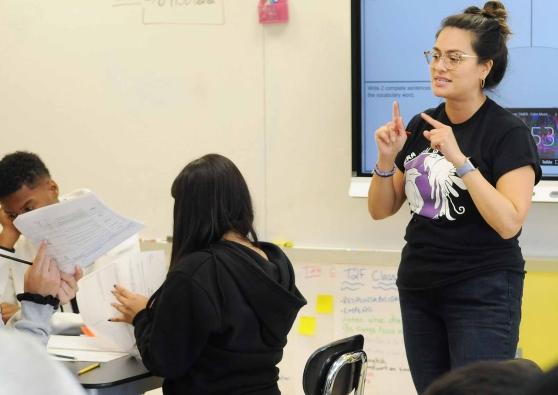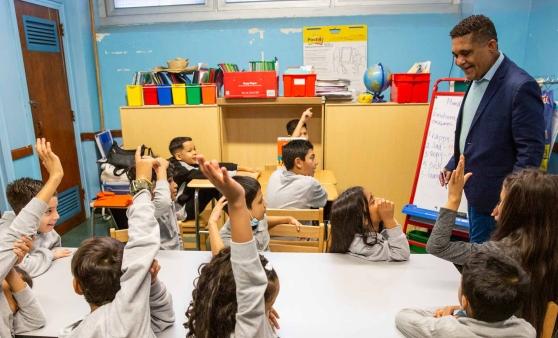Supporting migrant students

Bernadette Coyoy of Pan American International HS says integrating migrant students has gone smoothly because “this is exactly what we work for and train for.”
On top of all their other challenges, New York City public school educators face a new one this school year: the influx of about 6,000 migrant students from Venezuela, Honduras and other Latin American countries into city schools.
These children and their families were loaded onto buses from Texas and sent to New York City in what critics denounced as a “political stunt” by Texas Gov. Greg Abbott. Most now live in shelters scattered across the city.
The children arrived with profound academic, social-emotional and economic needs that UFT members are doing their best to meet.
Some regularly attended school in their home countries, while others had their education interrupted. Many speak only Spanish and, in a few cases, only an indigenous dialect.
At PS 16 in the Bronx, which received about 42 migrants in early October, the school’s English as a New Language teacher shares strategies to use with these students during the school’s professional development block, said Chapter Leader Jayme Morrissey. The school has established a peer support system in classrooms, where each migrant student is paired with a bilingual classmate. The ENL teacher does regular school walkthroughs to see what her colleagues need, Morrissey said.
Lacking enough Spanish-speaking educators, many schools have come up with creative ways to use the Spanish speakers they do have.
Liam Cleary, the chapter leader at PS 111 in Long Island City, said his school’s two ENL teachers and a handful of Spanish-speaking paraprofessionals and school safety agents have stepped up to assist.
Justin Ruddy, the chapter leader at the HS for Law Enforcement and Public Safety in Jamaica, Queens, said ENL teachers were working double duty, teaching stand-alone English classes and assisting fellow educators in teaching other subjects.
To address the systemic issue, UFT President Michael Mulgrew has asked state education officials to ease certification regulations so more Spanish-speaking educators already working in city schools can receive bilingual-education licenses more quickly.
Often the migrant kids came with just the clothes they had on, and their parents lacked basic supplies. Schools have stepped up to help.
At PS 16 in the Bronx, the staff organized clothing and food drives for the families. Morrissey said the school’s parent coordinator met daily with the migrant parents to give them basic information such as the location of supermarkets and churches.
The UFT is giving special priority to these children in its annual Thanksgiving coat drive.
The profound hardship these migrant families have faced was illustrated in the Sept. 18 suicide of a 32-year-old woman from Colombia who had arrived with her two school-age children on a bus from Texas this summer.
Shantae Jones, the chapter leader at PS 135 in Queens Village, which the woman’s 7-year-old daughter had attended, said the girl did not return to school following her mother’s death. Jolted by the tragedy, Jones said, the school set up a buddy program pairing teachers with migrant students and created a Saturday program to help the families learn English while assisting them with services.
Dealing with the new arrivals was less of a strain for schools such as Pan American International HS in Elmhurst, Queens. The school’s 486 students are all Latinos who have been in the United States for less than three years.
“This is exactly what we work for and train for,” said Pan American Chapter Leader Bernadette Coyoy.
For example, teacher Helio Sepulveda developed and runs a program at the high school to help students “acquire language through theater” while exploring history and literature.
Sepulveda said the school’s Peer Group Connection, in which 11th- and 12th-graders mentor new 9th-graders, has provided an additional layer of support.
Karla Pina, the school’s social worker, said Pan American reached out to all the migrant parents. In mid-September, more than 70 of them attended a Zoom meeting with school staff.
As they go to great lengths to welcome and support the new arrivals, educators across the city have been struck by these children’s eagerness to learn.
Karla Torres, a social worker at Dual Language MS on the Upper West Side, said the migrant students at her school have not had the same level of absenteeism that is typical of students with unstable housing. In fact, she said, the students continued to get to school each day even after many of their families were transferred from a shelter near the school to one in Jamaica, Queens, that was more than an hour away by subway.
“You can see the resiliency in them,” Torres said. “They like coming to school, and they try to speak to me in English.”
Cleary, the PS 111 chapter leader, said at the end of the day, it’s all about the children.
“The kids themselves are great,” he said. “If you show them an ounce of compassion and a willingness to try, they’ll jump through hoops for you.”
All the extra effort has been worth it, said PS 16 Chapter Leader Morrissey.
“We were nervous in the beginning,” she said, “but we pulled together as a community, and it’s been really positive.”
